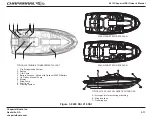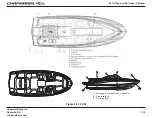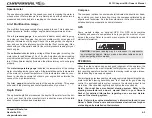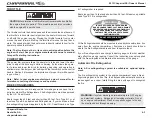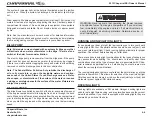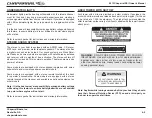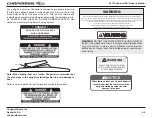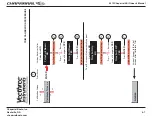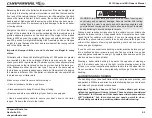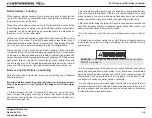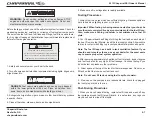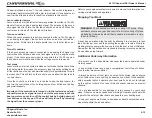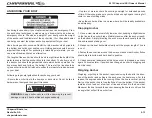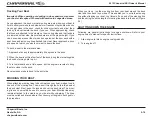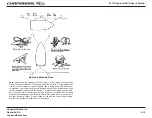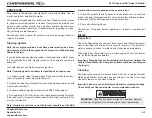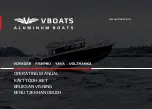
2013 Chaparral SSi Owner’s Manual
Chaparral Boats, Inc.
Nashville, GA
chaparralboats.com
5-4
Roller Trailers – Loading
When loading, always prepare for the procedure prior to reaching the
ramp. If the ramp is busy, preparation will shorten the time it takes for you
to get your boat out of the water.
Make sure your engine or drive unit is in the full position. Just as in the
launching procedure, do not put your trailer wheels or brakes in the water,
if possible. For the self-adjusting and centering rollers to work properly,
they must not be too far under water.
Unlock your winch and unwind enough cable/strap to attach the hook to
the bow eye of your boat. For safety, always keep at least three turns of
cable/strap around the winch drum. Never let your cable/strap all the way
out. Lock your winch before attempting to wind the cable/strap in.
Fasten the boat to the winch line and start winding. Strong wind and
current can affect the automatic adjusting capability of your roller trailer,
so be aware of those conditions while loading. Optional load guides can
help you keep your boat centered in adverse conditions. Pull the bow eye
tight to bow roller or vee block. Connect the boat bow safety chain and
you are ready to drive to the loading/preparation area near the ramp to
connect all other tie-downs, lighting or electric brake connections, etc.
Bunk or Custom Trailers—Launching
Here are some tips to remember when you are putting your Chaparral
boat in the water:
Important: Before launching your boat, make sure the transom drain
plug is installed. If it is not installed, the bilge could fi ll with water
quickly.
1. Always prepare the boat for launching before you get to the ramp.
Stop in a launching prep area near the ramp that doesn’t block traffi c
and remove your tie-downs, tilt up your engine or drive unit, replace your
transom drain plugs, etc.
2. Have someone at the ramp to give you directions. Slowly back the trail-
er down the ramp to the water. If there isn’t a ramp available, use a solid
area of ground to the shore, with a slope if possible. Avoid wet, soft sand.
Always remember to launch your boat at a right angle to the shore.
3. Back the trailer down the ramp until there is enough water to make the
boat fl oat. Because the bunks generate more friction than rollers, you
need to back the trailer further into the water.
• Tie a mooring line to the boat so you will have control once it is fl oat-
ing.
• Unfasten the boat bow safety chain. Hold the winch handle securely,
reverse the winch lock and begin unwinding the line. Unwind it slowly
and carefully.
WARNING
: If the winch handle slips out of your hand, let it spin.
DO NOT try to stop it
• On an average grade, the bunks on your trailer will allow your boat to
gently slip back and fl oat into the water. If your boat doesn’t immediately
move, try unwinding about six inches of line, lock your winch and give the
boat a push. Then unlock the winch and try again. If this doesn’t work,
you might try backing the trailer deeper, if possible.
• Care should be given when launching from trailers with bunks that are
equipped with plastic-like materials. These materials make the bunk sur-
faces very slippery, and the boat may begin to unload as soon as tension
is released on the winch cable/strap.



